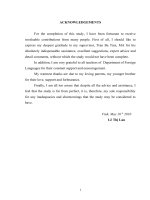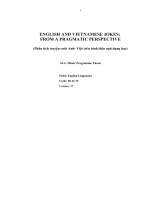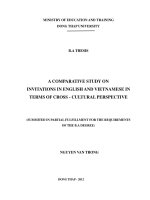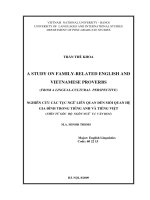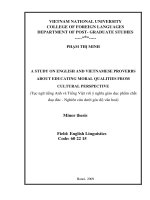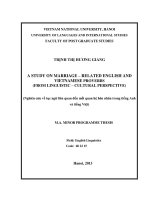A study on english and vietnamese greetings from a cross cultural communication perspective
Bạn đang xem bản rút gọn của tài liệu. Xem và tải ngay bản đầy đủ của tài liệu tại đây (502.72 KB, 82 trang )
MINISTRY OF EDUCATION AND TRAINING
HANOI OPEN UNIVERSITY
M.A. THESIS
A STUDY ON ENGLISH AND VIETNAMESE
GREETINGS FROM A CROSS- CULTURAL
COMMUNICATION PERSPECTIVE
(NGHIÊN CỨU VỀ LỜI CHÀO TRONG TIẾNG ANH VÀ TIẾNG VIỆT
TỪ PHỐI CẢNH GIAO TIẾP GIAO VĂN HÓA)
NGUYEN THI PHUONG THANH
Hanoi, 2016
MINISTRY OF EDUCATION AND TRAINING
HANOI OPEN UNIVERSITY
M.A. THESIS
A STUDY ON ENGLISH AND VIETNAMESE
GREETINGS FROM A CROSS-CULTURAL
COMMUNICATION PERSPECTIVE
(NGHIÊN CỨU VỀ LỜI CHÀO TRONG TIẾNG ANH VÀ TIẾNG VIỆT
TỪ PHỐI CẢNH GIAO TIẾP GIAO VĂN HÓA)
NGUYEN THI PHUONG THANH
Field: English Linguistics
Code: 60220201
Supervisor: Assoc. Prof. VÕ ĐẠI QUANG, Ph.D
Hanoi, 2016
CERTIFICATE OF ORIGINALITY
I, the undersigned, hereby certify my authority of the study project report
entitled “A study on English and Vietnamese greetings from a crosscultural communication perspective” submitted in partial fulfillment of
the requirements for the degree of Master in English Language. Except
where the reference is indicated, no other person’s work has been used
without due acknowledgement in the text of the thesis.
Hanoi, 2016
NGUYỄN THỊ PHƯƠNG THANH
Approved by
SUPERVISOR
Date:……………………
i
ACKNOWLEDGEMENTS
This thesis could not have been completed without the help and
support from a number of people.
First and foremost, I would like to express my sincere gratitude to
Assoc. Prof. Dr.Vo Dai Quang, my supervisor, who has patiently and
constantly supported me through the stages of the study, and whose
stimulating ideas, expertise, and suggestions have inspired me greatly
through my growth as an academic researcher.
A special word of thanks goes to all the teachers of the Post Graduate
Department of Hanoi Open University for their valuable lectures on many
aspects of my concern which laid the foundation for this thesis and many
others, without whose support and encouragement it would never have been
possible for me to have this thesis accomplished.
Last but not least, I am greatly indebted to my family, my friends for
the sacrifice they have devoted to the fulfillment of this academic work.
ii
ABSTRACT
Mastering a new language does not only consist of the ability to
master its system of form but also the ability to use its linguistic units
appropriately. This is because languages differ from one another not only in
their systems of phonology, syntax and lexicon but also in their speakers’
manners of pattering their discourse and relating speech act. Therefore,
people from different linguistic and cultural backgrounds come into
contact; there always exists the possibility for misunderstanding. This thesis
is an attempt to provide a cross-cultural comparison of greeting categories in
English and Vietnamese. The greeting categories are analyzed with data
taken from the questionnaires for the Vietnamese and English informants.
Utilizing contrastive analysis, the author analyzed the greeting categories in
English and Vietnamese. Results of the study showed that greeting is a
socially significant even in universal terms. Especially in Vietnamese,
greeting is an important part in cultural life. Some issues considered as “a
taboo” in English are used popularly in Vietnamese. These are the specific
cultural features in two languages. Then, some suggestions for the
Vietnamese learners of English are presented based on the theory and the
conductor’s personal experience after studying.
iii
LIST OF TABLES
Table 1: Austin’s classification of illocutionary act. .................................. 13
Table 2: Searle’s classification of speech acts. .......................................... 14
Table 3: Politeness Strategies (according to Brown and Levinson, 1987) .. 17
Table 4: Classification of illocutionary acts............................................... 22
Table 5: Survey for background ................................................................ 34
Table 6: Number of English and Vietnamese people using greeting
categories (direct and indirect greetings) .................................................... 48
Table 7: Some examples indirect greeting in English and Vietnamese ...... 48
Table 8: Some examples of strategic greetings in English and Vietnamese.53
iv
TABLE OF CONTENTS
CERTIFICATE OF ORIGINALITY......................................................... i
ACKNOWLEDGEMENTS ....................................................................... ii
ABSTRACT ............................................................................................... iii
LIST OF TABLES .................................................................................... iv
TABLE OF CONTENTS ........................................................................... v
Chapter 1: INTRODUCTION ................................................................... 1
1.1. Rationale for the study....................................................................... 1
1.2. Aims of the study .............................................................................. 2
1.3. Objectives of the study ...................................................................... 2
1.4. Scope of the study ............................................................................. 2
1.5. Significance of the study ................................................................... 3
1.6. Structural organization of the study ................................................... 3
Chapter 2: LITERATURE REVIEW ....................................................... 5
2.1. Review of previous studies ................................................................ 5
2.2. Review of theoretical background ..................................................... 7
2.2.1. Language and communication .................................................... 7
2.2.2. Cultural traits in greeting ............................................................ 8
2.2.3. Overview of speech acts ........................................................... 10
2.2.3.1. Definition of speech acts .................................................... 10
2.2.3.2. Components of Speech acts................................................ 11
2.2.3.3. Classification of Speech Act .............................................. 12
2.2.3.4. Politeness Theory. .............................................................. 14
2.2.4. Cross-cultural communication .................................................. 18
2.2.5. Overview of Greetings .............................................................. 19
2.2.5.1. Greeting as a speech act. .................................................... 19
2.2.5.2. Definition of Greetings ...................................................... 19
2.2.5.3. The pragmatic functions of Greetings ................................ 20
2.2.5.4. Types of greetings.............................................................. 24
2.2.6. Summary .................................................................................. 30
v
Chapter 3: METHODOLOGY ................................................................ 31
3.1. Research-governing orientations...................................................... 31
3.1.1. Research questions.................................................................... 31
3.1.2. Research setting ........................................................................ 31
3.1.3. Research approach. ................................................................... 32
3.1.4. Principles for data collection and data analysis ......................... 33
3.2. Research methods ............................................................................ 34
3.2.1. Major methods and supporting methods ................................... 34
3.2.2. Data collection techniques ........................................................ 35
3.2.3. Data analysis techniques. .......................................................... 35
3.3. Summary ......................................................................................... 35
Chapter 4: FINDINGS AND DISCUSSIONS......................................... 36
4.1. The categories of greeting in English and Vietnamese ..................... 36
4.1.1. Based on the structural and functional dimensions .................... 36
4.1.1.1. Direct greeting ................................................................... 36
4.1.1.2. Indirect greeting ................................................................. 38
4.1.2. Based on the contextual dimension ........................................... 42
4.1.2.1 Greeting on the run ............................................................. 42
4.1.2.2. Speedy greetings ................................................................ 43
4.1.2.3. The chat ............................................................................. 44
4.1.2.4. The long greeting ............................................................... 44
4.1.2.5. The intimate greeting ......................................................... 45
4.1.2.6. The business greeting ......................................................... 46
4.1.2.7. The introductory greeting................................................... 46
4.1.2.8. The re-greeting................................................................... 47
4.2. Similarities and differences between English and Vietnamese greeting
categories in terms of a cross- cultural perspective ................................. 47
4.2.1. Similarities ............................................................................... 47
4.2.2. Differences ............................................................................... 49
vi
4.2.2.1. The differences about the structural and functional
dimensions of greeting categories. .................................................. 49
4.2.2.2. The differences about the strategically dimensions of
greeting categories .......................................................................... 52
4.3. Implication in using greeting categories for Vietnamese learners of
English. .................................................................................................. 60
Chapter 5: CONCLUSION...................................................................... 62
5.1. Recapitulation.................................................................................. 62
5.2. Concluding remarks......................................................................... 63
5.3. Limitation of the research ................................................................ 63
5.4. Suggestion for further studies .......................................................... 64
vii
Chapter 1
INTRODUCTION
1.1.
Rationale for the study
In recent years, English has become an international language
used widely all over the world. It is not only the language of communication
and media but also the language of knowledge and culture. Mastering
English is considered an obligated condition for everyone in Vietnam
and it is implied to be a “passport” for a good job because English serves
their job and their promotion. Therefore, people pay more and more
attention to learning English. They no longer do grammar and translation
exercises only but listening skill and speaking skill have been invested
more time and better attention as well. As a result, English has been
learnt more properly and used more effectively.
However, in reality, Vietnamese learners of English often make
mistakes in communicating with English speakers. This is mostly caused
by the effect of Vietnamese culture and the limitation of understanding about
English culture. One of the most important parts in almost every
conversation is greeting which generally plays an important role in
communication and functions as a start of a conversation or indentify the
appearance of speakers or to express the respect to the listener. In addition,
greetings help to establish, maintain a relationship and facilitates the
conversation. As in Vietnam, greetings play an important role as these
sayings “Lời chào cao hơn mâm cỗ” or “ Dao năng liếc năng sắc, người
năng chào năng quen”. It means that Vietnamese are extremely serious in
greeting.
In fact, many Vietnamese people failed to continue their conversation
in English due to not only language ability but also understanding about the
1
culture of target language, English. In many cases, when being greeted by a
foreigner, many English learners feel confused to find out a good and
relevant response, some people cannot respond their partner’s greeting
immediately.
With all the above necessity, the author has chosen the topic “ A
study on English and Vietnamese greetings from a cross – cultural
communication perspective” with the expectation of finding out the
cultural similarities and differences between Vietnamses and English
greetings which partly helps Vietnamese learners of Engish have more
knowledge and skills in greetings, achieve more success in communicating
in English.
1.2. Aims of the study
The study aims at investigating the greetings in English and
Vietnamese, compare and contrast to point out the similarities and
differences of greetings categories in English and Vietnamese from a crosscultural perspective, to provide Vietnamese learners of English necessary
knowledge and skills in greetings.
1.3. Objectives of the study
To achieve the aims above, the following objectives can be put forward:
- Pointing out the categories of greeting in English and Vietnamese.
- Identifying the similarities and differences of greeting categories in English
and Vietnamese from a cross-cultural perspective.
- Providing the Vietnamese learners of English some implications in using
greeting categories.
1.4. Scope of the study
Academically, the greeting categories which are analyzed in this study
are English and Vietnamese in spoken form. The models of greeting
2
categorized and analyzed in this study include only the greetings that are
commonly found in daily communication and expressed to other(s) orally.
Moreover, greeting is one important part of language, especially is the
initiator of conservation. How greeting is used in different cultures,
particularly between English and Vietnamese is my great concern.
Therefore, the study focused on the cultural similarities and differences
between English and Vietnamese greetings; greetings in different social
encounters.
1.5. Significance of the study
Theoretically, major similarities and differences between the English
and Vietnamese speakers when greeting someone will be highlighted and
analyzed in great detail to add some certain theoretical background to study
English.
Practically, the findings of the study will increase readers’ awareness
of cross-cultural differences in order to avoid culture shock and to guarantee
successful communication. As a teacher of English, the author feels dutybound to raise her students’ awareness of conventional behaviors in common
situations and to incorporate the study of cultural behaviors as an integral
part of each lesson.
1.6. Structural organization of the study
The thesis consists of 5 chapters as follow:
Chapter 1 is the Introduction of the study which shows the reasons
why the topic is chosen, what the research aims at as well as the scope, the
significance and the structural organization of the study
Chapter 2 is the Literature review and Theoretical background of the
study. This chapter will give the brief review of related literature and
theoretical background of every matter mentioned in the study.
3
Chapter 3 is the Methodology in which the main steps and techniques
applied in the study such as data collection, description and comparison the
greetings between two languages is provided.
Chapter 4 is the Findings and Discussions. In this chapter, it presents
and analyzes the collected data from questionnaires as well as gives the
similarities and differences of using greeting categories in English and
Vietnamese.
Besides that, the study offers some implications for
Vietnamese learners of English in greetings are drawn out.
Chapter 5 is the Conclusion of the study which presents the
recapitulation of the study, the limitations of the study and some suggestions
for further study.
4
Chapter 2
LITERATURE REVIEW
2.1. Review of previous studies
Greeting is really an interesting issue in our daily life. It plays an
important role in communicative competence necessary for being a member
of any speech community. There are many famous Vietnamese and foreign
linguist and scholars having done researches on this linguistic field.
Ebsworth (1992) also indicated that greeting can be seen in the different
ways which cultures choose to perform these speech acts. Greetings in
American or British English are often produced by a serial turn taking of the
communicative partners. It was recognized that American greetings have a
greater variety because Americans make use of more creative language. It lies
in the fact that greetings as part of cross-cultural communication may vary
from lexical choices to substantial differences in cultural norms and values.
Greetings in American English consist of a range of linguistic and non-verbal
choices which may include a simple wave or smile, a single utterance, or a
lengthy a series of conservational turns.
Nodoushan (2007) provided some examples and explanations for the
most common used greetings in American English. He divided the greetings
in to two different types based on time: in time-free and time-bound.
Nodoushan (2007) also claimed that Americans tends to be more informal in
their daily life greetings. Except on official occasions such as reception of
distinguished guests, American society has a certain amount of informality in
introductions and greetings. On most occasions one need not be ‘particularly
conscious of social status, Americans generally ignore it’ (p.359). In spite of
the informality, however, there are rules of good manners and social patterns
that should be followed. There are rules of introducing people to each other.
5
A younger person is generally introduced to an old person, a man to a woman,
a guest to the host or hostess, and a person to the group Nodoushan (2007).
Dr. Maysa’a Kadhim Jibreen in “The Speech Act of Greeting: A
Theoretical Reading”. He has given definition of greeting, classification and
structures of greeting in term of semantic, syntactic and pragmatic. William.
K. (1997) in “An Evaluation of Greeting Exchanges in Textbooks and Real
Life Settings”. He has pointed out in general classifications of greeting.
In Vietnam, a great number of studies on greeting expression have
attracted learners of English such as Nguyen Phuong Suu (1990) focused on
investigating similarities and differences in the way Vietnamese and
Australian speaker greet and address in their own language and the underlying
factors that govern their choice of linguistic forms used in greeting and
address terms in order to find out what pragmatic transfer and interference
exists in Vietnamese- English interaction. The Australian subjects consider
the length of time they have been known each other and the context of
interaction the most important factors in greeting and addressing, whereas the
Vietnamese speakers are likely to see the age, the address as the most
important factor in greeting and addressing someone (Suu, 1990, pp.78-79).
Nguyễn Thị Bích Hằng (2009) in “ English analysis: English and
Vietnamese Greetings”, Huyền Vũ (2009) in “Cách chào hỏi của người Việt
và người Mỹ”, Trần Thị Bích Hạnh (2010) “Vietnamese and English
Greetings: A contrastive analysis ”, Huỳnh Thị Thanh Châu in “Greetings in
English and Vietnamese: A contrastive analysis” and Hoàng Thị Kim Dung in
“A cross-cultural study of addressing forms in greetings in Vietnamese and
English” , (2010), the study shows the similarities and differences in two
countries through their cultures in order to help the learner s avoid cultural
shocks or cross-cultural conflicts involving the addressing forms in greetings
in global communication. Trần Anh Vương in the research “Ways of greeting
6
and a comparison between Vietnamese and English greetings” studies on
greeting and greeting culture in English and Vietnamese. He also points out
the similarities and differences between them. However, his research is rather
wide. He infers both verbal and non-verbal greeting.
However, it seems there is a lack of a research which deals with the
differences between English and Vietnamese from a cross-cultural
communication perspective. That is the reason for this research to be done.
2.2. Review of theoretical background
2.2.1. Language and communication
Language is the remarkable system that allows people to communicate
an unlimited combination of ideas using a highly structured stream of sounds.
Or “language is the system of special signals which people use to
communicate and it is the basic means of communication and developing
thought of people. People use language to impart tradition, culture, history
and experiences from the old generation to the young generation”. It is the
method of human communication, either spoken or written, consisting of the
use of words in an agreed way. And there is no doubt that language is a
system for communicating.
When people want to tell each other something, language appears.
Apparently, language is the means of communication. Without language,
people cannot exchange information, experiences and share feelings, thought
with each other. People use language to express their thought, feelings, ideas,
experience. It is the reality of thought.
Communication is a process by which information is exchanged
between individuals through a common system of symbols, signs or behavior.
It is the activity or the process of expressing ideas, feelings or exchanging the
ideas, information with someone. It is clearly seen that the way we
communicate and the way we understand others’ communication are the
7
result of our knowledge and past experiences. That means communication can
take place anywhere and is carried out by anybody. In communication,
interlocutors show their attitude, relationship, mood, understanding, confusion
and a whole range of other things and convey a range of meanings in different
cultures, from insults to approval or even attraction. The participants do
anything to make others understand what they mean. The successful
communication means that the person receives the massage being intended.
To communicate successfully, the communicators must understand the other’s
needs, feelings, and ideas.
Language plays an important role in conveying people’s thinking and
expressing their feeling and attitude in daily communication, meanwhile,
greeting expression belongs to the language system. When meeting, people
greet each other by expressions (saying some words). So greeting is the
activity of giving speech or words to welcome someone. It is an important
part of communication, even compulsory. Participants are both speakers and
listeners involved directly in conversation. And using the way of greeting can
help us know interlocutors’ emotion, feeing as well as their knowledge,
culture, politeness and respect to each other. People who are involved in
conversation should depend on objects and other features of communicative
situation such as age, sex, family relationship, social status and power.
Language is used to communicative while greeting is a process of
communication. So greeting involves language which is known as greeting
language. It is one of the key changes to communicate effectively with
different people in different cultures.
2.2.2. Cultural traits in greeting
Culture is the combination of all the physical and behavioral aspects of
a society. Culture includes all knowledge, belief, art, morals, law, custom and
any other tradition and habits acquired by man as a member of society.
8
Culture is also a historically transmitted, socially constructed system of
beliefs, premises, symbols and their meanings that pertain to a group of
people. So we can consider culture a tool that our families and societies instill
in us to get through life. In Vietnamese, cross cultural is defined as the
contact, the affective exchange, the interaction among cultural aspects of
different ethnics. In English, culture is like an iceberg, most of which is deep
within the ocean just much of culture is deep within people. The tip of the
iceberg is easy to see. This includes the visible aspects and taboo of
communication on other cultures; the remaining huge chuck of the iceberg
hidden below the surface includes the invisible aspects of a culture such as the
values, traditions, experience and behaviors that define each culture.
The connection between the human capacities for culture and language
has been notes as far as classical antiquity, the relation between language and
culture is more complex than the coordinate title language and culture would
suggest. Language is, of course, an integral part of culture, defined
simplistically as the totality of beliefs and practices of a society.
Furthermore, the semantic content of language is always related to the
entities, events, states, processes, characteristics and relations within culture,
and culture depends in large measure on language in order to function and to
perpetuate itself. It is not strange, therefore, that most of the serious mistakes
in translation are the result of not recognizing the intimate relations between
language and culture.
Greeting expression is a phenomenon of language. And as language is
believed to be woven into every fabric of every human culture, it can be said
that greeting expression is an element of culture.
Although there are plenty of disagreements on the definition of culture
and the relation between language and culture, a majority of people agree that
culture overwhelms language and language reflects culture. Nevertheless,
9
cultural features vary from region, even when they speak the same language.
That is why their reflections in language are different. Greeting expression is
not an exception. It is influenced by cultures. Each country has its own
culture. So cross-cultural among countries can make greeting expression have
plenty of dissimilarities between Vietnamese and English cultures. Cultures
rooted in people’s awareness so deeply that they cannot be changed easily in a
short time. Each culture still has its own characteristics and dignity. These
dissimilarities between two cultures often create a phenomenon called cultural
shock when people from the two cultures endeavor to communicate.
The ways of greeting in Vietnamese and English are surely affected by
cultural features. To partially help avoid the cultural shock in this area, this
research will discuss some main characteristics of the way of Vietnamese and
English people’s greeting. It can also help us know more about the way we
can make a polite greeting.
2.2.3. Overview of speech acts
2.2.3.1. Definition of speech acts
The notion of “speech acts” and its theory were initiated by the
British philosopher Austin (1962), and then were further developed by
others such as Searle (1969, 1976), Leach (1983), Levinson (1983), Yule
(1996,1997). And all these speech act theorists share the view that there is a
close link between speech acts and language functions.
Austin (1962:147-149) points out many functions performed by
utterances as part of interpersonal communication. Particularly, he says that
many utterances do not communicate information, but are equivalent to
actions. They are “words that do things” in the world and in saying
something the speaker does something. Besides, Austin originally (1960:52)
used the term “speech acts to refer to an utterance” and the “total situation
in which the utterance is issued”. (Thomas,1996:51).
10
Sharing with Austin’s ideas, Richards, Platt, J. and Platt, H.
(1992:342) defines, “speech acts is an utterance as a functional unit in
communication”. Also, Yule (1996:47) states, “Actions performed via
utterances are generally called speech acts”. These speech acts are
commonly given such specific labels as apologizing, complaining,
complimenting, inviting, promising or requesting etc.
Thus, their common assumption is that when conversing people use
grammatical and lexical units not only to produce utterances, but also to
perform actions. These speech acts, considered as minimal units of human
communication, are performed in actual situations of language use – as
Searle (1969:16) says, “…. Speech acts…are the basic or minimal units of
linguistic communication”.
2.2.3.2. Components of Speech acts
According to Austin’s theory (1962), the act is performed under any
of the three forces; what we say has three kinds of meaning which Trung
(2013:105) called three components namely locutionary, illocutionary, and
perlocutionary.
Locutionary Force : is what produces the act of “saying something”,
i.e., the act of uttering a certain sentence with a meaning.
Illocutionary Force: In performing a locutionary act , we may also
perform such an act as questioning, promising, warning, ordering, etc.
Thus, the words have the force of a question a promising, a warning, an
ordering, etc. Austin made a distinction between a locutionary act and an
illocutionary act as one between the act of saying and the act in saying
something, respectively. The latter is the inherent function of the speech
act, which might be established by simply looking at the act itself in
relation to existing belief. For example, “I’ll help you” could be considered
11
to be a promise if one believed that the hearer would be pleased at the
news.
Perlocutionary Force: is one that produces the consequential effects on
the speaker or hearer’s feelings, thoughts or actions. For example, the acts
of coming of the speaker and the expectation of the hearer for the speaker
to come will be the effects of the promise “I’ll come”.
2.2.3.3. Classification of Speech Act
There are thousands of possible illocutionary acts and several attempts
have been made to classify them into a small number of types. Two main
approaches to classifying speech acts have been distinguished: Austin’s
(1962) is principally a lexical classification of illocutionary verbs, and
Searle’s (1976) solution to classifying speech acts was to group them in the
five macro-classes (clarified in Cutting, J, 2002:16-17)
According to Austin’s classification (1962:151), Illocutionary act are
classified into five functions namely:
Speech act
Functions
Examples
types
Verdictives
acts that consist of delivering acquit, hold (as a matter of
a finding
Exercitives
law), read something as, etc.
acts of giving a decision for appoint,
or against a course of action
dismiss,
order,
sentence, etc.
Commissives acts whose point is to commit contract, give one’s word,
the speaker to a course of declare one’s
action
Behabitives
expressions
intentions, etc
of
attitudes apologize,
thank,
toward the conduct, fortunes, congratulate, welcome, etc
or attitudes of
12
others
Expositives
acts of expounding of views, deny,
inform,
concede,
conducting of arguments, and refer, etc.
clarifying
Table 2.1: Austin’s classification of illocutionary act.
According to Searles’s classification, speech acts was to group them
in the five macro-classes: declaratives, representatives, expressives,
directives, and commissives.
Speech act types
Functions
Representatives
Commit the speaker to the truth
of the expressed proposition.
Asserting, concluding
Examples
- “The
Moon
goes round the
Earth"
- "It is windy
today."
Directives
Attempts by the speaker to get
the addressee to do something.
Requesting, questioning
- "Stand up,
please!"
- "Could you
open the
door?".
Commissives
Commit the speaker to some
future course of action.
Promising,
threatening,
- "I’ll give one
hand."
- “ I’ll be back”.
offering
Expressives
Express a psychological state.
Thanking,
apologizing,
- "What a great
party!".
13
welcoming, congratulating
Declaratives
Effect immediate changes in the
- "Priest: I now
institutional state of affairs and
pronounce you
tend to rely on elaborate extra-
husband and
linguistic institutions.
wife."
Excommunicating,
declaring war, christening,
firing from employment
Table 2.2: Searle’s classification of speech acts.
2.2.3.4. Politeness Theory.
Politeness, an issue which has a great impact to human being and
deeply influences to human interaction, will be now discussed right in this
part because
Politeness is basic to the production of social order, and a
precondition of human cooperation ... any theory which provides an
understanding of this phenomenon at the same time goes to the foundation of
human social life.
(Brown and Levinson, 1987)
Concept of politeness
Many linguists share their understanding and their concern on the
concept of politeness. Brown and Levinson (1990:2), in their introduction to
“Politeness- Some Universal in Language Usage”, emphasize that “the issues
of politeness raise sociological speculations of this scale; they also touch on
many other interests and many other fields”.
14
Hill et al (1986:349) define politeness as “one of the constraints on
human interaction, whose purpose is to consider other’s feelings establish
levels of mutual comfort, and promote rapport”.
The notion of politeness has been largely discussed. Lakoff (1975:64)
sees politeness as “a system of interpersonal relational designed to facilitate
interaction by minimizing the potential for conflict and confrontation inherent
in all human interchange”.
According to Nguyen Quang (2005:185), “Politeness refers to any
communicative act (verbal and / or non-verbal) which is intentionally and
appropriately meant to make others feel better or less bad”.
Politeness strategies
Linguists have stated different ways of expressing politeness strategies.
Among them, the most influential theory of politeness is put forward by
Brown & Levinson. According to Thomas the Brown and Levinson’s “has
been extraordinarily influential and very widely discussed” (Thomas, 1995).
Although there might be some criticism, such as a few overlaps and
borderlines between positive and negative politeness, their theory can reliable
serve as a theoretical framework for cross-cultural research.
Positive politeness strategies
Positive politeness is directed to hearer’s positive face, his “perennial
desire that his wants should be thought of as desirable” (Brown & Levinson
1987, 101). By using positive politeness strategies, the speaker conveys that
they are co-operators with the address and that they have a common ground.
Brown and Levinson (1987) list 15 positive politeness strategies. With
first eight of the strategies, the speaker claims common ground, “indicating
that S and H belong to the same set of persons who share specific wants,
including goals and values” (p.103). The latter strategies are used to convey
15
that speaker and hearer are co-operators and have the same goals.
Consequently, if speaker requires something from the hearer, he can use the
strategies to hint that by attending to the speaker, the hearer is acting in his
own interest as well.
Negative politeness strategies
Negative politeness in Brown& Levinson (1987:129) is considered as
“regressive action addressed to the addressee’s negative face: his want to
have his freedom of action unhindered and his attention unimpeded”.
Agreeing with Brown & Levinson on definition of negative politeness,
Nguyen Quang (2003) emphasizes “Negative politeness is in any
communicative act which is appropriately intended to show that speaker does
not want to impinge on the addressee’s privacy, thus enhancing the sense of
distance between them”.
In short, “negative politeness” involves the speaker and hearer’s
independence. This is also known as the “formal politeness strategy” which
creates the distance between the speaker and hearer. In most English speaking
countries, people are more inclined to employ negative politeness strategies.
However, what politeness strategy is preferred by what culture suggests a
problem. In many Oriental Languages, including Vietnamese, negative
politeness is not always put in a high place. Vietnamese people tend to use
positive politeness to show concern to others and narrow the distance between
the speaker and the hearer.
Strategies
Strategy 1
Positive politeness
Notice, attend to H (his
Negative politeness
Be conventionally indirect
interests, wants, needs,
goods)
Strategy 2
Exaggerate (interest,
Question/ hedge
approval, sympathy with H)
16




